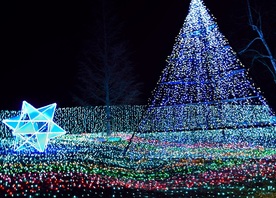An iconic symbol of Japan, Mount Fuji is one of the most prevalent depictions found in Japanese culture, and it appears throughout the art, literature, and religion across the land. Every year natives and tourists alike flock to witness the beauty of the landscape firsthand. With enough courage to take on the challenging one-to-two day hike, they set off on one of the four trails — each of which offers its own degree of difficulty. Despite the enduring nature of the trek up Mt. Fuji, the picturesque landscape on which it lies offers scenic photos and unforgettable memories that make it all worth the while.
Mt. Fuji Hike
Though hiking in Japan is a popular endeavor, hiking to the summit of Mt. Fuji is an entirely different undertaking. Often, a once-in-a-lifetime opportunity, Mt. Fuji welcomes hikers from far and wide. The ascent usually begins around nightfall so that hikers have the opportunity to see the sunrise from the summit. From there, hikers make the descent down during the morning hours.
The total trip lasts anywhere from 8 to about 16 hours, depending on the trail chosen. Individual trails are suited to hikers’ needs and abilities, ranging anywhere from beginner to expert, though even the beginner trails offer their own level of difficulty.
Where Is Mt. Fuji?
Mt. Fuji, or Fujisan in Japanese, is situated about 135 kilometers Southwest of Tokyo on the island of Honshu. Due to its location between the prefectures of Yamanashi and Shizouka, nearly every side of the mountain offers an impressive view. Depending on the trail, the mountain is easily accessible by means of trains and buses.
For travelers looking for the most efficient route, the Kawaguchiko Train Station can be found just outside of the base. Many hikers make use of the Japan Rail Pass in order to minimize their spending, as well as decrease the amount of time taken to actually travel to and from the mountain.
Mt. Fuji Elevation
The total elevation of the mountain is a steep 3,776 meters. As Japan’s tallest peak, Mount Fuji’s elevation can pose a physical challenge even if the hike itself is relatively straight-forward. As the elevation increases, breathing gets difficult, even for the most experienced hiker. Many have gone into the hike underestimating just how much of an elevation change there is. Upon leaving the 5th station on the Yoshida Route, the elevation rises a sharp 1,500 meters to the summit. Located on a relatively small island, Mt. Fuji’s elevation is quite different from most of Japan’s terrain.
Mt. Fuji Trails
Varying by the level of difficulty, hikers can choose from four different trails:
- Yoshida Trail — The most popular is the Yoshida Trail, as it the most accessible from the city. Many hikers enjoy the beautiful views of the sunrise both at the summit, and also along the descent.
- Fujinomiya Trail — The second most popular is the Fujinomiya Trail as it is also quite accessible. In fact, the trail has bus lines that run to and from the Shinkansen stations. However, the trail comes with its downsides; hikers have no view of the sunrise as the hike is performed on the western side of the mountain. Additionally, the ascent and descent follow the same path, so congestion among hikers is always possible.
- Subashiri Trail — Though less traveled on, Subashiri arguably offers the most — a plethora of views, a prime location for the sunrise, and a separate little hike to see Kofuji are just a few of its notable features.
- Gotemba Trail — As the most difficult trail, Gotemba is not for the faint of heart. For hikers up for the challenge, however, Gotemba is the least crowded and. For about one-third of the descent, hikers can literally run or slide down volcanic gravel. The famous volcanic portion of the mountain is known as the Osunabashiri, or “great sand run.”
How Long Does It Take to Hike Mt. Fuji?
Depending on the trail, the conditions at the time, and the hiker’s individual stamina, the length of the journey will vary. Each of the trails has guidelines as to their level of difficulty, as well as the projected amount of time needed to hike them.
The Fujinomiya Trail is typically the shortest, with an ascent that lasts around 4-7 hours and a descent around 2-6. Generally, the descent is shorter no matter what trail is chosen.
The next shortest is a toss-up between the Yoshida Trail and the Subashiri Trail. For the Yoshida Trail, the ascent lasts around 5-7 hours, while the descent lasts around 3-5. Comparatively, for the Subashiri Trail, the ascent lasts around 5-8 hours, while the descent lasts around 3-5.
The longest of the four trails is unequivocally the Gotemba Trail, with an ascent that can take up to ten hours and a descent of around 3-6.
Hikers also have the option of spending the night at the summit. Most hikers seem to opt-out of this option, and instead begin their journey at night, arriving at the summit just in time for the sunrise. After all, Japan is nicknamed the “Land of the Rising Sun.”
Can You Hike Mt. Fuji in June?
Unfortunately, the amount of time per year that the mountain is fully open for climbing is limited. Due to harsh weather conditions, it’s in a hiker’s best interest to climb Mount Fuji during its official season. The official season for the Yoshida Trail opens July 1st and lasts until September 10th. All other trails open on July 10th. During that time hikers can enjoy amenities, such as mountain huts, medical supplies, food and drink, and guided tours.
Conversely, the off-season offers virtually none of these same amenities. Nevertheless, for experienced hikers and climbers, there still are opportunities to make the trek in the off-season. Though the mountain hike does not offer the same sport climbing experience found in other parts of Japan, there are still steep trails to challenge even the most experienced climbers.
Is Mt. Fuji a Volcano?
Mt. Fuji is a near-perfect cone-shaped volcano. In fact, the mountain is actually comprised of two volcanoes; the Old Fuji and the Young Fuji. The last time the volcano erupted was December 16th, 1707. During the eruption, heaps of volcanic ash were released over the terrain creating the now-famous Osunabashiri, as mentioned above.
Is Mt. Fuji Active?
Mt. Fuji is active, though it is good to reiterate that it hasn’t erupted since 1707. At this time, hikers do not need to worry about the volcano erupting anytime during their hike.
Interested in reading more about climbing in Japan? See our article on Everything You Need to Know About Rock Climbing in the 2020 Tokyo Olympics.




